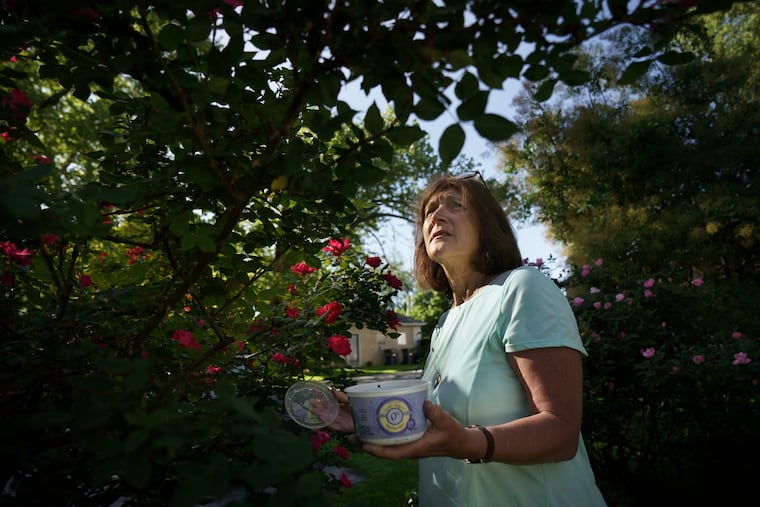The spotted lanternfly is back. This Chesco woman is the bug assassin we must all become. | Maria Panaritis
The Lanterfly is here. Hatching and feasting on our roses. And come August, crashing our barbecues like flying cockroaches, clanging against our windows, our screen doors, our very last nerve.

Lorraine Phillips of Phoenixville is at war. Which is strange, since she’s not a killer type. But in times of invasion, even the kindhearted realize it is essential to bear arms and take no prisoners. So Lorraine has became a coldhearted suburban assassin.
Her mission: Search and Destroy. Her foe: an advancing adversary whose very name increasingly incites fear and loathing in Southeastern Pennsylvania since first making an unwelcome landing from Asia in 2014.
The spotted lanternfly.
“I’ve killed probably over 1,000 in the last two days, and every time I look there’s more and more,” she told me soon after announcing her unpleasant discovery on Facebook a few days ago. “It’s war in my backyard.”
Her war is our war. The lanternfly is back, and now in 14 counties near Philadelphia. They are hatching eggs and feasting on our roses. They will potentially destroy some important Pennsylvania crops. And, come August, they will be crashing backyard barbecues like giant, flying cockroaches, clanging against windows, screen doors, and our very last nerve.
Lorraine’s discovery of a swarm of nymphs in her Chester County yard marks the start of a seasonal war with a bug that is so invasive that even the Pennsylvania Department of Agriculture’s hotline number cuts right to the chase: 1-888-4BAD-FLY.
“If you can knock them into a bucket of sudsy water or use insecticidal soap or another EPA-registered insecticide — never spray insecticide on blooming plants because we don’t want to affect pollinators that are coming to those blooms,” lanternfly expert Emelie Swackhamer of Penn State Extension told me Thursday. “Try to kill them. They’re an insect we want to try to destroy.”
How bad are these horrible pests? You wouldn’t believe — or then again, maybe you would — the extreme measures some have taken.
Bleach. Gasoline. Stuff that, let’s just say, backfires in many ways.
“If they jump up on your face and you’ve sprayed them with bleach,” Emelie explained without so much as a trace of sarcasm, “you will see how that’s not a good practice.”
Lorraine is no flame-throwing, gasoline-dousing warrior. She was born in London and got her gardening passion from British grandparents. She is also that rare human who can temper her anger while focusing like a heat-guided missile on her target. (The 50-something has brought that same Zen to the recent heartbreak of being laid off a few months ago after 29 years as an advertising professional.)
Her weaponry against the lanternfly is simple but unsparing.
It’s a 16-ounce Greek-yogurt container. She uses the lid to scrape scores of baby flies off the succulent young branches of her fully bloomed Knock Out Rose bushes. Her other hand holds a container of apple cider vinegar, dish soap, and water.
Bucket of Death, I call it. It is glorious.
Nymphs drop in and down they go, sinking to the bottom of the toxic swimming pool where they meet their maker.
Mwah hah hah haha!
“I guess there’s a dark side to me,” she said with a barely noticeable deadpan. “It’s almost a game now. You know?”
Just then, she spotted another batch on a branch:
“Oh, crap!” she said.
I stepped back.
Lanternflies are “hitchhikers.” They travel like a mooching relative — via the backseat of your car, the cuff of your jeans, a wooden storage palette. I was keeping my distance. How rude, I told Lorraine, the way they were putting her through so much trouble.
“That’s right,” she said, this time with a smile. “The bastards.”
It’s important to kill as many as possible at all stages to keep these pests from laying eggs later this year. The first sighting ever was in Berks County five years ago. The lanternfly has been migrating east ever since, landing in Philly last year.
Twitter last year was a hotbed of hysteria as people saw them for the first time. Same on Facebook on Monday after Lorraine shared photos.
""They’re all over my yard and plants. Bastards," wrote someone.
“UGH, they are overwhelming!!” wrote another.
And, of course: “KILL THEM NOW!!”
I first spotted this bug at a Berks County diner maybe two summers ago. I’d parked and headed for the diner door only to be greeted by a swarm of clunky and one-inch-long winged creatures. They were hanging and banging around like bored teens at a Wawa parking lot.
It. Was. DISGUSTING.
Scientists are racing to find ways to contain this pest. The lanternfly could cause billions of dollars in damage to Pennsylvania’s apple and grape crops. There is worry, even, all the way in California.
Until then, there is but one option: MURDER.
Don’t have the stomach for it? Consider Lorraine. She is Zen even while attacking.
“Nature is my therapy,” she said. “I love nature. Even when nature is my enemy.”
An assassin with a heart. Just what we must all now become.